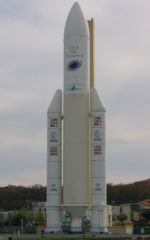
 |
| Ariane 5, Rocket that launched the ATV, Image: Poppy, GFDL |
An Ariane 5ES rocket has launched the first Automated Transfer Vehicle or ATV. The spacecraft, named Jules Verne, and also known as ATV-001, has been described as the most advanced ever built in Europe. It will now begin about a month of testing, prior to its scheduled docking with the International Space Station (ISS) in early April. The launch of the ATV marks the culmination of a thirteen-year development programme, and the start of a six-month mission to test the spacecraft and resupply the ISS. Arianespace conducted the launch on behalf of the European Space Agency, who will be responsible for the ATV’s operation. A second burn of the upper stage was performed at around 05:06 GMT. Launch operations concluded with spacecraft separation from the carrier rocket at 05:09, and control of the ATV was transferred to the French space agency, CNES, who will control it from a centre in Toulouse. Deployment of the spacecraft’s solar arrays was confirmed at around 05:40 GMT.
The Ariane 5ES rocket, which was making its maiden flight, lifted off from ELA-3 at the Guiana Space Centre at 04:03:04 GMT this morning. The Ariane 5ES was designed primarily to be used for European government programmes, such as the ATV, and Galileo. It uses the first stage of a heavy-lift Ariane 5ECA, with a restartable upper stage from the Ariane 5GS. It will replace the Ariane 5GS, which is scheduled to retire later this year. It is the first European launch of the year, with the next, using an Ariane 5ECA, scheduled for early April, with Brazillian satellite Star One C2 and Vinasat-1, the first Vietnamese spacecraft. The next ATV is scheduled for launch in late 2009.
The ATV will remain in orbit for around six months, before being replaced at the ISS by a smaller Russian Progress spacecraft. When this happens, the ATV will be de-orbited, and will burn up on re-entry. The launch is the culmination of thirteen years of planning and preparation, and the programme is already three years behind schedule. The launch of Jules Verne had previously been delayed from July, September and November 2007, and from February 2008. A further delay, from Saturday, was caused by a problem with the system that the ATV uses to separate from its carrier rocket.
Speaking after the launch, Arianespace chairman Jean-Yves Le Gall remarked that the launch was “perfect”, and that the launch shows that Europe is a “major player” in manned spaceflight. ESA administrator Jean-Jacques Dordain commented that ESA was “embarking on an extraordinary voyage”, and that “as of today ESA is an essential partner…of the International Space Station”. He also said that Europe was “on [its] way to becoming a major partner in the ISS”, and that the successful launch “would not have been possible the support of ESA’s member states”.
The ATV’s launch comes two days ahead of the scheduled launch of the next mission to visit the Space Station, Space Shuttle Endeavour, which will begin mission STS-123 at 06:28:12 GMT on Tuesday. Endeavour will deliver the first pressurised section of the Japanese Experiment Module, and the Canadian-built Dextre component for the Space Station’s robotic arm.
Several hours after launch, a problem was reported to have developed with the number two Propulsion Drive Electronics (PDE) unit. This is responsible for control over a quarter of the ATV’s manoeuvring thrusters. All engine burns have been delayed or cancelled whilst the fault is investigated.
This is the eighth orbital launch of 2008. The 20-tonne ATV is the heaviest spacecraft ever launched by a European rocket.
Source: Wikinews